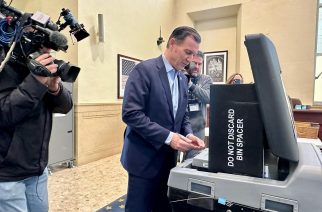
After a year of high-profile corruption cases in the state Legislature, 89 percent of registered voters say corruption in state government is a “serious” problem. More than half — 53 percent — call it “very serious” — and two-thirds say corruption is a serious problem among legislators from their area.
Sixty percent say the job of state legislator should be made full time and that outside income should be banned. Fifty-five percent of registered voters do not want state legislators to get a raise from the current base salary of $79,500 even if outside income is banned, according to a new Siena College poll of New York State registered voters released this week.
Many of the proposals outlined in Gov. Andrew Cuomo’s combined budget and State of the State address are popular with voters.
There is overwhelming support for stripping pensions from convicted legislators and enacting paid family leave. More than 60 percent of voters support gradually increasing the minimum wage to $15 per hour, allocating $300 million to the state Environmental Protection Fund, and eliminating the LLC loophole in campaign contributions.
“New Yorkers’ confidence in state government in Albany hovers at historic low levels. Nearly nine in ten voters say corruption is a “serious” problem in Albany, with more than half saying it’s “very” serious. Nearly two-thirds think corruption among state legislators from their area is a serious problem.
The Senate and the Assembly are each viewed favorably by fewer than 40 percent of voters,” said Siena College pollster Steven Greenberg.
“Even if the Legislature was full time — and all outside income banned — by a 55 to 42 percent margin, voters give a thumbs down to a raise for legislators from their current $79,500 base pay. It’s an issue Democrats, Republicans and independents agree on, and while New York City voters are closely divided, downstate suburban and upstate voters are strongly opposed to a pay raise for legislators, even with a ban on outside income,” Greenberg said.
“Two of the governor’s proposals related to this are strongly supported by voters,” Greenberg said. “By a 70-point margin, 84 to 14 percent, voters support stripping pension payments from state legislators convicted of crimes related to their public service, regardless of when the official was first elected. And by a 59-35 percent margin, voters support limiting legislators’ outside income to 15 percent of their salary, or about $12,000 currently.
“As we move into a legislative election year, ethics reform has become a more important issue for voters than it was at the start of last year. One-quarter of voters say it’s one of the top two issues they want the governor to address — up from 19 percent last year, and nearly half of voters say the recent corruption scandals make it less likely that they will re-elect their state legislators,” Greenberg said.
Two social reforms proposed by the governor last month are popular among those polled. “Cuomo’s paid family leave and minimum wage proposals are strongly supported by New Yorkers,” Greenberg said. “Republicans are the key reason why paid family leave is supported by 80 percent of all voters, while minimum wage is supported by 65 percent.
“Two Cuomo proposals – the Dream Act and a $3 billion renovation of Penn Station — get a thumbs down from voters,” Greenberg notes. “The Dream Act continues to be strongly supported by Democrats and more strongly opposed by Republicans. Strongly supported by New York City voters and strongly opposed by voters outside the City, the overall narrow opposition to the Dream Act has been largely consistent over the last three years.
“Renovating Penn Station — one of the governor’s high profile, high dollar infrastructure proposals — is strongly opposed by upstate voters, Republicans and independents,” Greenberg said. “Among New York City and downstate suburban voters, as well as Democrats, the results are mixed, as all three are closely divided.”
The top three issues for Democrats are education, jobs and ethics; for Republicans the priorities are taxes, jobs and education; and for independents the priorities are education, taxes and jobs.
“Regionally, New York City voters see education and jobs as far and away the top two, with health care a distant third; downstate suburbanites focus on education and taxes, with ethics and jobs tied for the third spot; while upstate residents say education, with jobs and taxes closely behind,” Greenberg said.
Nearly half of voters, 47 percent, think New York should spend what the governor is proposing to spend on education aid this year ($24 billion; 4.3 percent increase), while 27 percent want to spend more than the governor proposes and 23 percent want to spend less.
When it comes to overall state spending on education right now, 56 percent say New York spends too little, 27 percent say the right amount and 14 percent say too much. “A plurality of voters from every region, along with Democrats and independents agree with spending what the governor proposes for education aid this year, while Republicans are divided between what the governor proposes and less than what the governor proposes,” Greenberg said.
“Two-thirds of Democrats, nearly half of independents and a plurality of Republicans think New York spends too little on education, as do a nearly two-thirds of New York City voters, a majority of upstaters and a plurality of downstate suburban voters,” Greenberg said. “Half of white voters say New York spends too little, while more than two-thirds of New Yorkers of color say that.
“The governor can rightly point to the fact that half of New Yorkers agree with his proposed spending level on education. However, the Legislature traditionally looks to increase funding for education , because a majority of New Yorkers think the state spends too little on education,” Greenberg said.
The poll was conducted January 24 to 28, via phoning conducted in English to 805 New York state registered voters. It has an overall margin of error of 4.0 percentage points.









